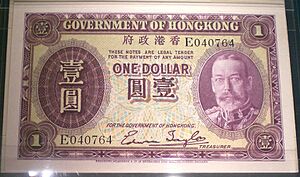Hong Kong one-dollar note facts for kids
| (Hong Kong) | |
|---|---|
| Value | 1 Hong Kong dollars |
| Width | 126 mm |
| Height | 79 mm |
| Security features | Watermark |
| Paper type | Cotton |
| Years of printing | various years |
| Obverse | |
| Design | Queen Elizabeth II |
| Design date | 1934? |
| Reverse | |
| Design | Stylised |
| Design date | 1934? |
The one dollar note was a special piece of money in Hong Kong. It was a paper bill worth one dollar. This note has an interesting history, changing hands from a bank to the government over many years.
Contents
Early Bank Notes: The HSBC Years
The very first one dollar notes were printed by a bank called The Hongkong and Shanghai Banking Corporation, or HSBC for short. They started issuing these notes in 1872. For a long time, HSBC was the only bank that made one dollar notes.
First Designs and Colors
When HSBC first made the one dollar note, it looked quite different. The front (called the obverse) was brown, and the back (the reverse) was red. It was also quite large, measuring 189 by 123 millimeters.
Changes Over Time
Over the years, the one dollar note changed its look several times:
- In 1889, the design was updated. The note became smaller, 129 by 86 millimeters. The colors changed too: blue on the front and red on the back.
- Another new design came out in 1904. This note was 132 by 90 millimeters. It had a green front and an orange back.
- By 1923, the size changed slightly to 131 by 93 millimeters. Both sides of the note became green.
- The last one dollar note from HSBC was issued in 1926. This design was 131 by 95 millimeters. It featured a blue front and a purple back, both with a yellow background.
Government Takes Over: New Era for the Note
In 1935, the Government of Hong Kong took over the job of printing the one dollar notes. This meant the government became the sole issuer, or the only one allowed to print them.
Royal Portraits and Color Shifts
Once the government started issuing the notes, they added a picture of the British monarch (the King or Queen of Britain at the time) on the front.
- These notes were first printed in purple until 1942.
- During World War II, the notes were replaced by Japanese Military Yen.
- After the war, in 1945, the one dollar notes were printed again, but this time they were light blue.
- In 1949, the color changed again to green. Even with these color changes, the main design and features of the note stayed the same, except for the portrait of the monarch.
The one dollar note continued to be issued until 1960. After that, it was replaced by a one dollar coin, and paper notes of this value were no longer made.


